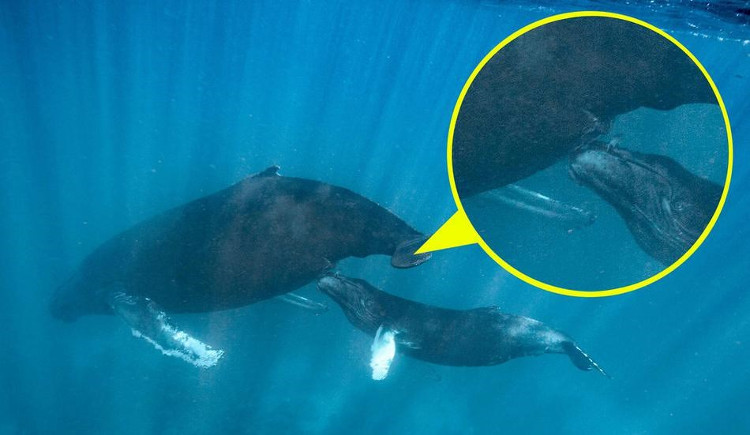How is the secret of feeding a whale?
In one day, the baby can drink between 380 and 570 liters of milk. But do you know how whales are breastfed when they don't have milk-like lips and cheeks?
Whale species have evolved from terrestrial mammals (most probably from common ancestors are ungulate predators, and other co-evolved sister branches are clam animals even (Artiodactyla) like pigs and hippos). They may have adapted to ocean life about 50 million years ago.

Rare photos of breastfeeding.(photo: Sina).
A blue whale can weigh up to 400 tons and has an average lifespan of 30 to 40 years (can also reach 80 to 90 years). Blue whales are not only the largest mammals, but also the largest animals ever known.
Their average body length is 25m (male) and 26.2m (female). The longest blue whale was discovered in 1909 in the southern Atlantic Ocean. Its length is 33.58 m.
Scientists believe that blue whales reach mating when they are 5-15 years old. After successful mating, children will become pregnant for 10-12 months. Their mating and reproduction activities usually occur during the winter.
Unlike other whales, blue whales often move alone. But by the end of July and early August, they began to pair a male one by one. The male will follow the female during that time.
Blue whale weighs about 2.5 tons, 7 m long from birth. In one day, juveniles can drink between 380 and 570 liters of milk, consume 4,370 kilograms of calories per kilogram, so their volume increases very fast at about 90 kilograms every 24 hours. The blue whale is weaned about 6 months after birth.
When breastfeeding, the whale's tongue curls up similarly to a straw and milk passes through it. According to the anatomy of Joy Reidenberg, the whale is 'necessary, especially when they are in water and this fish has no lips and cheeks to contain liquid'. Whale's milk is like a toothpaste, containing 50% fat.
- Revealing secrets to help whales dive 'super good'
- The secret of whale jaws
- Search for the whale 'Forever Alone' most on Earth
- The secret of the killer whale
- The whale's longevity secret is curved
- Heroic scene of massacre of whales, sea water changed color
- Use robots to study an endangered whale
- Rare whales drift on American beaches
- Whale carcasses the US coast
- Total whale 'population inventory'
- Female whale shark is a
- Why does the whale's body explode?
 Surprised: Fish that live in the dark ocean still see colors
Surprised: Fish that live in the dark ocean still see colors Japan suddenly caught the creature that caused the earthquake in the legend
Japan suddenly caught the creature that caused the earthquake in the legend A series of gray whale carcasses washed ashore on California's coast
A series of gray whale carcasses washed ashore on California's coast Compare the size of shark species in the world
Compare the size of shark species in the world